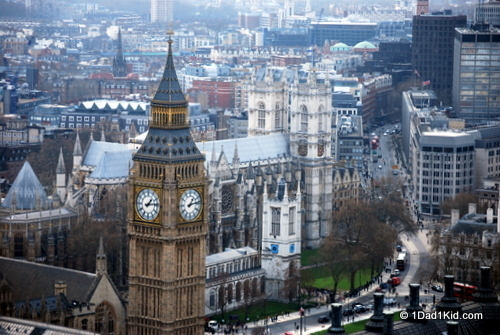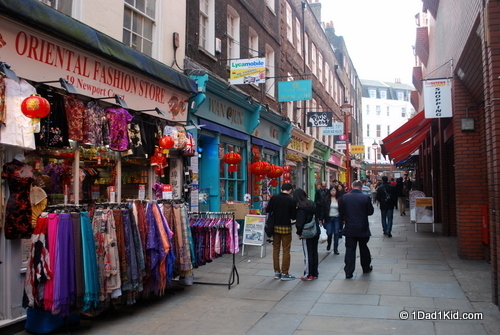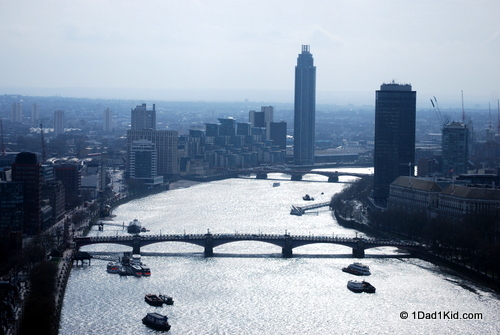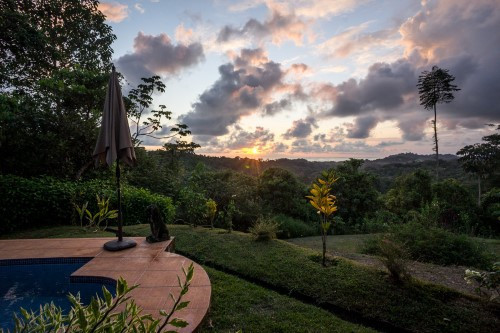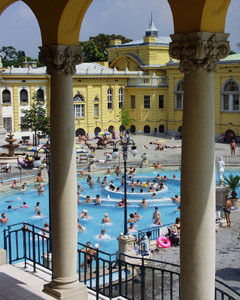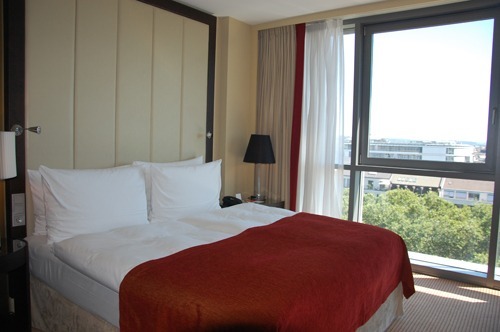Rolf Potts's Blog, page 43
April 16, 2014
We all see the same sun
Vagablogging :: Rolf Potts Vagabonding Blog
Each time I touch my feet to the soil of a new country, I am reminded of just how huge our world really is. Every so often, I catch my breath when I think about the diversity of our cultures, the depths of our oceans, the span of our land, and the sheer volume of people that call earth “home”.
I am simultaneously pulled along by an undeniable knowledge of our interconnectedness. Of a deep understanding that while I may not be able to see it “all”, that shouldn’t really be my goal anyway. Those who have come before have seen quite a bit and those who come after will see quite a bit more. My role in the march of time is to witness this world as it is, right now, and to participate as honestly as I can in our collective life on earth.
No matter where I go, the sun rises and the sun sets and it is this simple rotation of the earth that keeps me rooted to the fact that there is no “other” when it comes to our collective humanity. A day is always beginning and ending somewhere on earth and we all lays eyes upon the same sun, no matter what corner of the earth we inhabit.
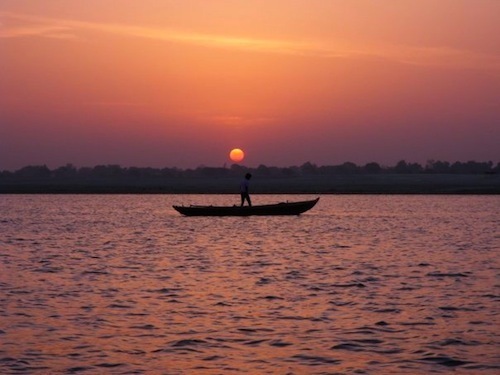
Sunrise over the Ganges River- Varanasi, India
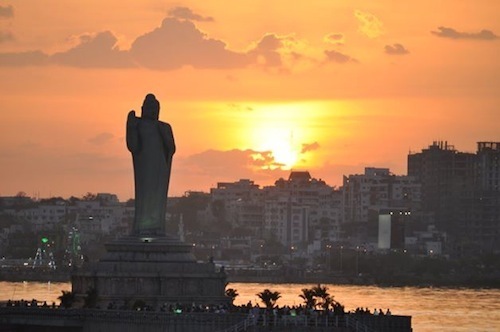
Sunset in Hyderabad, India

Sunset in El Tunco, El Salvador
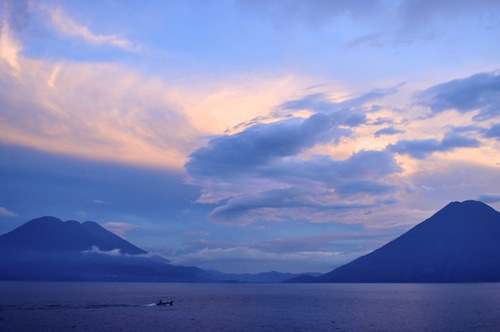
Sunset over Lake Atitlan, Guatemala
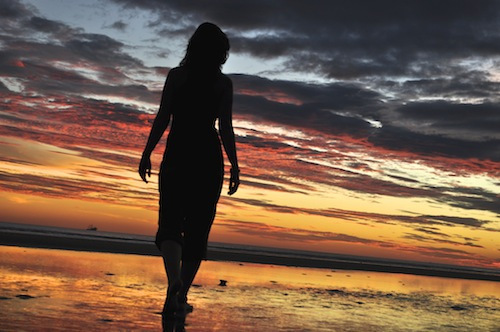
Sunset at El Cuco Beach, El Salvador

Sunset over El Cuco Beach, El Salvador
How could we not feel connected, knowing that we are looking at the exact same sun, no mater what corners of the earth we travel to?
Original article can be found here: We all see the same sun
April 15, 2014
Vagabonding field report: London,UK
Vagablogging :: Rolf Potts Vagabonding Blog
Cost/day: ~$40 USD (we had free lodging)
What’s the strangest thing you’ve seen lately?
I don’t know that I would say anything was particularly strange, but London has a lot of quirkiness, especially when it comes to street art. The East End is likely the most notable area for street art, and you’ll find examples all over the place. In terms of art installations, anyone is pretty much welcome to add to the collection, so you’ll find art of all kinds adorning buildings and signs, from the small to the gargantuan.
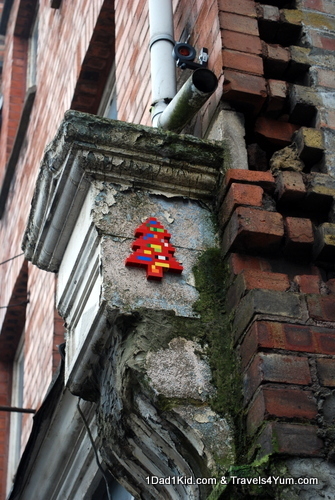
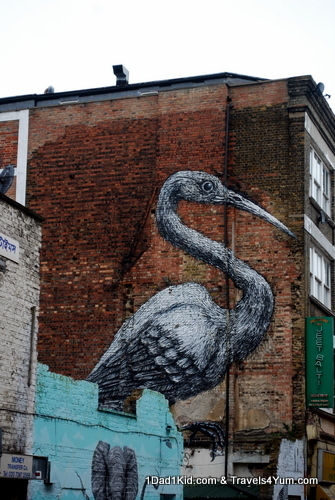
Some of the older buildings have been declared as heritage sites, so their facade has to remain intact. You’ll also find many buildings with the windows bricked over. This is because at one time they used to tax people according to how many windows they had. So some people simply bricked them over to pay less tax.

This is the front of someone’s apartment. It’s a heritage site, so they can’t change the exterior.
Describe a typical day:
As is often the case, London is best explored on foot or bicycle. There is an extremely robust (and expensive) transportation system. We usually would take the tube (the underground metro) to a spot and walk around from there. Once you’re in central London or a large neighborhood (like the East End), it’s really quite easy to see a lot of things by walking around.
In fact, you can see most of the major iconic landmarks without wearing holes in your shoes. Buckingham Palace, Trafalgar Square, 10 Downing Street, Big Ben, the Houses of Parliament, the Tower Bridge, and the London Bridge are all within reasonable distances of each other.
Describe an interesting conversation you had with a local:
We didn’t really have that many chats with people. Most of our experience was asking people for directions. For being in quite a large city, I was surprised at how friendly Londoners were, and they were always seemingly happy to help. We did do a rather wonderful food tour, however, which was run by a local. We learned a lot about local history and culture as well as some of the historical buildings in the area. We even stood near the site where Jack the Ripper’s first victim was found. Quirky is a big theme here.
In that tour we learned why proper English tea is black. They used to drink only green tea, but people started just adding colors to it to make more money. The dyes were making people sick, so they switched from green to black tea, and it’s been that way ever since.
What do you like about where you are? Dislike?
I loved London’s quirky side, but the history was a big winner for me. Almost everywhere you turn is a building or site that has some historical renown. It was quite impressive to walk among buildings dating back hundreds of years and see them still in use. For example, the huge Victoria Tower is actually now an archive for Parliament.
London has so much to see and experience, and I also loved the rather plentiful ethnic diversity.
Describe a challenge you faced:
The biggest challenge was financial. If your bank account uses the US dollar, you’re at a major economic disadvantage in the UK. We were lucky that we had a friend who lives in London and was on holiday, so we were able to stay in their flat at no charge. Otherwise, I doubt we could’ve afforded to stay a week in the city. There are definitely ways to make a visit cheaper, but it’s still a hit on the wallet.
What new lesson did you learn?
I can’t say it’s totally new, but I learned that it really is valuable to see a city for yourself and not just rely on the experiences of others. London had never really been high on my list of places to see. In fact, I had absolutely no plans on visiting it, but my son was eager to see the Tower of London and ride the London Eye. Since were flying into London on our way to a house sit in North Yorkshire, I figured why not stop. I’m so glad we did because London ended up being one of my favorite cities.
Where next?
Brasov, Romania
You can follow along or learn more about our adventures on our blog and by connecting with us via Facebook.
Original article can be found here: Vagabonding field report: London,UK
April 14, 2014
Housesitting: A strategy to lower costs and extend travel
Vagablogging :: Rolf Potts Vagabonding Blog
When I handed in my resignation letter, put what few belongings I hadn’t sold into storage and packed my life into a 55L rucksack, I became a vagabond.
Without bricks and mortar, without a stable income and without fear of regret, I altered the direction in which my life was headed and set off to travel the world.
Long term travel is a romantic notion, one that many aspire to but never achieve.
Why?
In my opinion it boils down to finance. The thought of removing oneself from a stream of regular income is a little daunting. In the modern world we tend to financially tie ourselves to possessions, there’s always some form of credit we’re paying off; mortgages, cars or that spur of the moment shopping spree. It’s hard to imagine how we’d remove ourselves from the perpetual cycle of earning and spending a wage.
Not only that, but travel can incur high costs. With airfare and accommodation capitalizing a large percentage of a traveler’s budget, it can be difficult to imagine living in relative comfort with what remains.
So what if I told you that I’d be living rent free in locations across the world for the last 3 years?
What if I told you that I’d found a way to almost negate accommodation costs from eating into my budget?
For those who are familiar with the concept you’ll no doubt have guessed that I have achieved this seemingly impossible feat because I am a house sitter. Signing up to Trusted House Sitters a little over 3 years ago, I’ve travelled the world and lived rent free in 17 properties and 6 different countries to date.
Keeping my spend on airfare to a minimum, my travel style is akin to that of the tortoise rather than the hare. I choose to explore each country for as long as visa restrictions dictate rather than hop from one location to another. Coupled with the fact that I often apply for house sitting assignments back to back, my daily budget is significantly lower than the average traveler.
Many twenty something travelers choose to focus their itinerary plans on countries where the cost of living is lower, as this allows them to maximize their spending power. As a twenty something traveler who is also a house sitter I’m not limited in this way. I’ve greatly reduced the cost of my stay in 2 of the top 10 most expensive capital cities in the world and lived in luxury free of charge.
The truth is that house sitting is the main reason I have been able to sustain my travels for so long.
So what is house sitting? What does it involve and how would you go about incorporating an assignment into your travels?
House sitting is essentially an exchange of services. Home owners employ the services of a house sitter to care for their property and pets for an agreed period of time. As a house sitter I am tasked with basic property maintenance, pet care and occasionally I will be asked to maintain a garden or manage the care of a swimming pool.
More often than not my daily responsibilities are no more than I would have in my own property. I follow instruction regarding housework, tend to the needs of any animals and ensure I am present at the house to deter opportunistic theft.
While in my case no money changes hands – some sitters do charge for their services but this means when house sitting abroad it is necessary to obtain a work visa – the exchange of peace of mind for the home owner and rent free living for me, works pretty darn well.
It’s important to note that each assignment is unique, as is each home owner and their needs will vary depending on the circumstance. It’s not uncommon for sitters to literally step into the owner’s shoes so keep that in mind when applying for assignments.
Rural properties often come with more animals, more feeding, grooming and shrubbery pruning but in my opinion that’s all part of the experience. City penthouses and family homes in the suburbs each have their own character, their own insight into life in the locale.
The opportunity to sample cultures from around the globe is something that entices many sitters; I know I tend to seek out opportunities that give me the chance to try my hand at a new way of living.
My CV includes a city townhouse, a rural lifestyle block complete with spitting alpacas, a macadamia nut farm and an off the grid Central American retreat. Each assignment presented challenges but also taught me how to adapt and consider the benefits of each way of life.
The concept of house sitting has altered the way I travel, that is clear. I now plan my itinerary around the assignments I secure and have seen many parts of the world those who follow the tourist trail do not.
Each assignment has afforded me the chance to channel my travel funds into experiencing life at the location to the full, and finance my onward travel when the owners return.
I utilise house sitting assignments to subside the cost of my vagabond existence and I’m proof that you can leave the security of your job in the city without regret.
Original article can be found here: Housesitting: A strategy to lower costs and extend travel
April 13, 2014
Being a stranger in a strange place is a kind of liberation
Vagablogging :: Rolf Potts Vagabonding Blog
“The freedom of being a stranger in a strange place, knowing no one, needing to know no one, with no obligations, elicits deep feelings of liberation. The farther from the beaten path I go, the quicker my attachment to any idea of how I should be treated is discarded — I’m grateful merely that my needs are met. Without an agenda, or company to distract me, I invariably feel a certain hopelessness that can appear contrary to my aimlessness. Perhaps it’s just the simple joy of being alive.”
–Andrew McCarthy, The Longest Way Home (2012)
(2012)
Original article can be found here: Being a stranger in a strange place is a kind of liberation
April 12, 2014
An Introduction to the Budapest Bath Experience at Széchenyi
Vagablogging :: Rolf Potts Vagabonding Blog
Finding yourself tired and achy after a long day’s sightseeing in Budapest? That can be easily fixed by indulging in one of the city’s great experiences—a long soak in the healing waters that residents and visitors have been availing themselves of since Ottoman times. Blessed by its location—it sits above numerous natural springs spouting warm water fortified with minerals—the Hungarian capital offers visitors some of the world’s great public bath experiences.
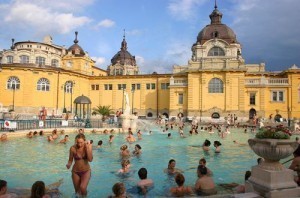
Szechenyi Thermal Baths, Budapest
With over fifty baths, spas and public pools, Budapest wisely takes full advantage of the waters burbling up from its sediment. The experience of the spa/bath has become a way of life in this city, and integral part of its social fabric. Some baths date to the sixteenth century when the Ottomans first indulged in the bath craze, and others date from the early twentieth century. It is not unusual for a Hungarian physician to prescribe a visit to the baths, such is the strength of Hungarians’ belief in the restorative powers of the experience.
There are dozens of great thermal baths to choose from, but for the first-time visitor the popular Széchenyi offers a fine look into a top-notch Budapest bath experience. Housed in a grand old yellow building situated in the City Park, the enormous complex with the Baroque copper dome looks like every bit the grand nineteenth-century retreat it is; a recent renovation has given the historic building a fresh coat of gleam.
The brainchild of a Budapest mining engineer, Széchenyi was the first thermal bath on the Pest side of the city, with records showing that an artisanal bath existed on the spot by 1881. By 2014 a full panoply of options existed, including an outpatient physiotherapy department.
Upon entering, you’ll choose the options you want (children under 2 are free and there is a special student discount), rent your towel, and hit the locker room to change. If you get lost in the complex or just plain overwhelmed by the choices, attendants in white will try their best to assist, though many do not speak English. This being Europe, there are some swimsuit-optional areas, but the American visitor will be happy to know that most patrons are covered—minimally, by severely strained Speedos—but still covered.
Settling into the hundred-degree water, stress tends to melt away like an ice cube under a blazing summer sun. There is nothing to do but watch the other visitors, a great European pastime. An observant guest will find a feast of people-watching opportunities such as blissed-out regulars playing chess in their Speedos and local big shots discussing weighty political matters while struggling to stay awake in the relaxing water, their eyelids heavy as steam swirls around them. Don’t worry; you almost certainly be the only tourist there.
There are older, more historic spas and thermal baths in town (some of the Ottoman-era spas) and swankier spas (the Gellert Baths are justifiably popular) but for a locally-loved and affordable introduction to Budapest’s water wonders, spending a lazy afternoon relaxing under Széchenyi’s glimmering domes is a great way to start.
For a trove of information on spas and bath experiences around the world, visit http://findmesauna.com/ run by spa connoisseur and world traveler Sandra Hunacker.
Original article can be found here: An Introduction to the Budapest Bath Experience at Széchenyi
April 11, 2014
Leaping Without The Pile in the Back of the Closet
Vagablogging :: Rolf Potts Vagabonding Blog

The pile in the back of the closet
Petrified, excited, invigorated, exhilarated, daunted…I felt them all in the weeks leading up to my first round the world journey. So many emotions, so little time. All the planning for this idea of taking a hiatus from the everyday was thrilling, yet frightening. From visa applications to inoculations (those weren’t fun) and new passport pages to hotel bookings the excitement continued to grow. But then it was six weeks before, one-month prior and days ahead of wheels up and the packing began. First world problem, no question; but all the worries came to a head with this-will I be okay without the ‘just in case stuff’ in the back of my closet?
You know that pile with the favourite t-shirt from university, the worn out jumper from sleep-away camp or those old standby jeans for the ‘I’m feeling fat’ days…where would you be without them? Was I really worried about ‘stuff’? We’ve all experienced that tug and pull in our own way. At this point, on this day, this was mine. Hindsight is twenty-twenty; was it really the stuff or was it something else? It’s what many who have made the leap to long-term travel have experienced with similar stories about managing on far less than in their pre-long-term travel days. But, I was stuck. Collapsing in a heap beside the flung open closet door staring at the ‘stuff’, I sat. The fashion consultants on What No To Wear would have thrown it out years ago since it’s been that long since I put my hand on it, but it was comforting to know it was there. Smaller after bouts of culling and donating, but, still there. I knew that pile held far more than clothes.
One backpack was all I allowed myself. If it didn’t fit it wasn’t coming. If it didn’t have more than one purpose or matched with three other things it wasn’t making it. I cried. Having looked forward to this journey for over a year, was I really crying over STUFF? Really? Wrapped up in this stuff were worries of everything and nothing. Would we be okay? What if something happened to someone I love? Who would keep in touch? What if everything changed when we were gone? The anticipation and worry manifested in that tiny pile in the back of the closet. The pile, that metaphor for the ‘what ifs of the world’ had taken hold and had me in its grasp. There were memories of time passed mixed with the notion of the unknown possibilities for a time yet to come. The crying continued. Logically, I knew how lucky we would all be if this truly was one of the most difficult decisions to make (perspective is a wonderful thing), but still, it was hard. On a precipice filled with greater meaning, this felt like one of those teachable moments. Either choice was fine, but I knew one led to a new journey in both destinations and personal growth while the other stayed stuck with the unchanging ease of ‘the devil you know’. Getting to the place to make the jump was a journey in itself and this felt like a turning point. Stay with the comfort of the pile or embrace the idea that you hold the key to the meaning of the pile? The rest is just that, ‘stuff’.
It didn’t make it into the backpack and after awhile I got up off the floor. I wasn’t yet ready to get rid of the pile but I was ready to close the closet door and leave room in the bag for the unknown future. The pile didn’t win. It remained, for the time being, in the back of the closet (to be revisited at a later date) and I took comfort in the knowledge that it was there. This journey to a place open to the risks and rewards of the frightening while slowly disentangling from the worries of the ‘what ifs’ is a continual one but each step does make a difference. Long-term travel was ahead with indeterminable adventure and experiences far greater than the stuff could ever hold. It is worth the risk. Maybe I wasn’t yet ready to discard the pile from the back of the closet entirely, but I was able to close the door and open a new one.
Traveler 1-Pile 0.
What’s your ‘pile’? What helped you make your leap?
Original article can be found here: Leaping Without The Pile in the Back of the Closet
April 10, 2014
Vagabonding Case Study: Louise Lakier
Vagablogging :: Rolf Potts Vagabonding Blog
Louise Lakier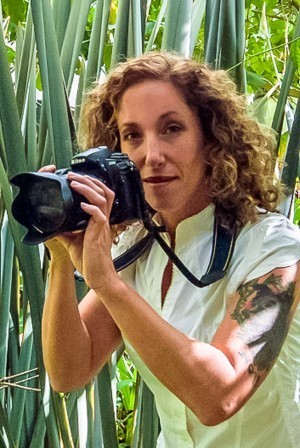
Age: 45
Hometown: is not an easy one to answer so I will give you the place I was born: Johannesburg South Africa
Favorite Quote: “And the day came when the risk to remain tight in a bud was more painful than the risk it took to blossom” ~Anais Nin
How long were you on the road?
I have been ‘on the road’ since September 2012. I am traveling my way back to South Africa and eventually to Melbourne. But I am quite open and spontaneous and plans move, flow, shift, and change. Anything is possible. I am searching the planet for interesting stories, imagery and experiences.
Where did you go?
I have been up and down the Northwest coast from Vancouver to the Rogue River, Nicaragua, Dublin, London, Costa Rica, Panama
What was your job or source of travel funding for this journey?
I have a photography and travel writing business. I used to write and photograph for an online design magazine and would scout out interesting homes wherever I roamed. I also wrote for a travel blog. Now I am focused on my own travel blog sharing stories of interesting and unique places to stay. My specialty is resort photography providing imagery updates for websites. My background is in architecture and design, so I come with a passion for creative spaces! A reliable source of income has come from selling images to print publications. My next few goals include revamping my blog to be an income source and pitching stories to print travel magazines.
Did you work or volunteer on the road?
I work and volunteer on the road, sometimes for room and board, sometimes for stories and imagery, depending on the location and the situation.
Of all the places you visited, which was your favorite?
One of my favorite experiences was running a 50k on Ometepe Island, Fuego y Agua, and volunteering to photograph their Kid’s Run. Another favorite was visiting and photographing the beautiful Casitas at La Loma Jungle Lodge in Bocas del Toro.
Was there a place that was your least favorite, or most disappointing, or most challenging?
I find some areas where there are large communities of expats to be challenging. These communities tend to be a bit tightly-knit. Playa Gigante and Granada, Nicaragua were challenging in this way but the Nicaraguan locals I met in both areas were so warm. Working on the road can be difficult, limited internet, and often the wifi available is in a defined common area. These can sometimes be noisy and distracting or out in the elements. Bocas del Toro was a challenging place to hunker down and work, it was also quite magical and full of fantastic imagery.
Which travel gear proved most useful? Least useful?
My rolley bag! I was so stubborn for so many years but lugging photography gear around just gets too heavy. I love my rolley bag.
My Loewpro Camera Bag backpack. It fits everything I need, is compact and comes with a raincoat.
My tripod. I roll it up in my yoga mat and carry the two together. Works really well and I always have two of my favorite things with me.
Least useful: Anything paper, as in reference books and notebooks. They get crumpled, moist, and moldy.
Heavy boots. I miss them. But heavy camera equipment takes precedence. I travel with my Vibram five fingers. They are light and take up very little space in my bags!
What are the rewards, as well as the challenges and sacrifices, of the vagabonding lifestyle?
The rewards of this lifestyle are the connections you make with people from all over the world, locals or fellow travelers. Every experience is different and new. There is always something to try you have never encountered before, a new fruit, a new language, a tribe of people you never knew existed, an animal or bird seen for the first time. The sacrifices are constantly packing and unpacking or living out of a bag, having to stay two steps ahead for planning, not having an address, and sometimes going days without someone with whom to share a meaningful conversation. The biggest challenge I have found traveling alone is getting sick and not having someone close to check in on me. This happened while staying at a Wellness Center! Friends tell me they are jealous I have the freedom to travel. I tell them the opportunity exists for them to have this lifestyle but they will have to redefine the meaning of home and let go of material things.
What lessons did you learn on the road?
Lessons learned: To always have a plan A, B, & C. To rely on myself completely. To cherish the kindred spirits. To listen to and follow the energy. To really let go of material things, moisture, dust and wear and tear from constant use will claim everything eventually, sometimes a robbery will too. If I am healthy and have access to the essentials, a good nights rest, food, water, the ability to communicate with the outside world, I am off to a good start! I tend to love spontaneity. The most important lesson I have learned on the road, is a little bit of planning, is a lot of self-care.
How did your personal definition of “vagabonding” develop over the course of the trip?
I started off referring to myself as a gypsy, now I refer to myself as a traveling freelance writer and photographer.
Any advice or tips for someone hoping to embark on a similar adventure?
Buy a rolley bag. Browse sites like Caretakers.org and Workaway.info for volunteer and housesitting opportunities.
When and where do you think you’ll take your next long-term journey?
I am not sure I will ever stop:)
Read more about Louise, or follow them on Facebook and Instagram.
Website: Louise Lakier Photography
Twitter: @LouiseLakier
Are you a Vagabonding reader planning, in the middle of, or returning from a journey? Would you like your travel blog or website to be featured on Vagabonding Case Studies? If so, drop us a line at casestudies@vagabonding.net and tell us a little about yourself.
Original article can be found here: Vagabonding Case Study: Louise Lakier
April 9, 2014
How Kayak.com can help you get a free room
Vagablogging :: Rolf Potts Vagabonding Blog
Whenever someone has no frequent flier miles, no ability to get travel-rewards cards, and really wants a cheap domestic flight, I always send them to Kayak. Kayak.com is a popular travel search aggregator that scans all the other travel search aggregators and shows you the cheapest rates it finds. It does all the comparison work for you and that’s why so many people love it.
But what makes Kayak so lovable in my mind is its ability to help you get free hotels.
To explain this, I’ll have to explain what a “BRG” or Best Rate Guarantee is.
1.) Best Rate Guarantee Policies
The BRG strategy is one of my favorite tricks because not only does it often get us a room that costs no money, it won’t cost us points either. Furthermore, it’s a trick that anyone can use as it doesn’t require you to sign up for any kind of credit-card or promotion or anything.
So what is this BRG policy?
This is simply a promise a hotel makes that they will offer a better price for their rooms on their own website than they will on any search aggregator like Kayak, Travelocity, Expedia, etc. My guess is they set this up as an accountability system to make sure they keep on top of the prices they’re releasing to these aggregators, and that they’re correcting the price anytime an aggregator’s price is listed too low.
First, I’ll share with you the basic steps of applying for a BRG, then I’ll share with you a few hotels with the most generous BRG policies.
This is where Kayak.com comes in and shines.
1.) Find a hotel you’re interested in that advertises a BRG policy.
This includes so many hotels that I probably don’t need to name them, but the ones that are most likely to result in a free room are InterContinental and Hilton. We’ll discuss the specifics of their policies and others below. Here is the most complete list of BRG policies we could come up with.
2.) Find a cancelable rate on that hotel’s own website- a rate you think you’ll be able to match or beat.
We book cancelable rates just in case the hotel decides not to approve our claim- then we’re not left with an expensive hotel when we meant to have a free one.
3.) Use Kayak.com’s “search by brand” feature to find the EXACT same room.
This needs to be more exact than finding a “Hilton standard room” if you’ve booked a Hilton standard room. Depending on how picky the hotel is and how badly they don’t want to approve your BRG, you need to make sure no listed detail contradicts the hotel’s own website description. Check-out time, breakfast or no breakfast, etc.
We’ve been told that because breakfast was included on the cheaper rate we found on an aggregator, but not included in the rate on their own website, it wouldn’t be considered the “same room.”
This even goes for the currency the price is listed in. Luckily, Kayak has a country selection that will allow you to see only rates listed in that country’s currency. OR sometimes you can go to the site Kayak has pulled up for you and change the currency from there.
Really though, only some of the hotels are so picky about a matching room description and because you booked a cancelable rate, if you think the description is close enough, you can always try!
4.) Obviously, most importantly, make sure the room Kayak has shown you is cheaper.
This may take a bit of hopping back and forth from the brand’s website to the aggregators, but other times you’d be surprised how easy it is to find a cheaper rate.
5.) Now it’s time to submit your claim.
This is a simple process that happens online.
Hilton’s BRG claim form can be found here.
IHG’s BRG claim form can be found here.
Choice’s BRG claim form can be found here.
And Marriott’s BRG claim form can be found here.
As I mentioned above, our favorite use of the BRG strategy is with hotels whose BRG policies are generous enough to allow a free room.
Whose policies are the most rewarding?
InterContinental Hotel Group is a hotel chain that includes Holiday Inn, Holiday Inn Express, Crowne Plaza, IHG, etc. Their BRG policy states that if you find a cheaper rate for their rooms on someone else’s site, they’ll give you “your first night free.” Naturally, we take advantage of this by aiming for BRG’s at their nicest brand, InterContinentals, and by booking one night stays so our whole stay is free.
Hilton is a hotel chain that includes Hampton Inn, Waldorf, Conrad, Double Tree, and Hilton, etc. Getting approved for their BRG claims will either give you a $50 Amex gift card (for domestic stays) or a $50 price reduction (Internationally.) We take advantage of this by trying to book rates that are as close to $50 as possible.
Best Western basically offers a $100 Best Western voucher for approved BRG claims. So your initial stay won’t be free, but your next one would be as there are plenty of Best Westerns for $100 or less. Also, by the time you have one $100 voucher, you could submit a BRG claim for another stay, paying for that stay with a voucher and receiving another voucher for your next stay. And on and on and on. But there are a few more rules to this, which you may want to familiarize yourself with.
These are just a few of the most generous Best Rate Guarantee policies. But there are so many more Best Rate Guarantee policies out there.
Thanks to Kayak.com, the hunt for an approved BRG claim can be pretty easy.
Original article can be found here: How Kayak.com can help you get a free room
April 8, 2014
Vagabonding Field Report: The coast of El Salvador
Vagablogging :: Rolf Potts Vagabonding Blog

Cost/day: $55/day
What’s the strangest thing that’s happened lately?
Between my husband and my son, they were stung three times during the one week we were in El Salvador!
 Describe a typical day:
Describe a typical day:
We’re driving most days, exploring the coast and searching for a place where we could possibly rent a house. Stopping at towns along the way, such as El Zonte, San Blas and Liberia, we check out the beaches and rental prices.
The roads are windy along the coastline in the north, with cliffs that offer vistas of the sea. Sunshine reflects off the ocean. The breeze blows, the windows are down and our favorite tunes are playing on the radio. It’s great to be alive, exploring this big, beautiful world!

What do you like about where you are? Dislike?
Like: There are no speed bumps! After being in Guatemala for so long and their countless tumulos it’s refreshing to be able to drive without slowing down for speed bumps.
The people are super friendly, and love the children. They are constantly coming up to us every time we stop and asking questions.
We also found a great little place to hangout in El Cuco… a great campground with a pool and a short jaunt to the beach.
Dislike: We’re shocked with the prices here — food is about 20% more than Guatemala (we’d heard it was cheaper), and rental rates are outrageous! Prices are high, but the ‘niceness’ of accommodations are not. This was not at all what we expected. We can only surmise that rates are being driven up because the coast of El Salvador is very popular for surfers.
Describe a challenge you faced:
We’d hoped to find a house to rent for a month or two, but all rental rates were outside of our budget, and even if they hadn’t have been, nothing we found would work for our family of seven (soon to be eight.) Given my condition of being 6 months pregnant, I was disappointed by having my expectations unrealized.
What new lesson did you learn?
Expect the unexpected. You never really know what a destination has to offer until you hit the ground. Besides, everyone’s desires are different, so it can affect what their experience is like.
Where next?
We’re heading to Nicaragua where we hope to find a house on the beach that we can rent for a few months.
See more family travel adventures, connect with me on Facebook, or learn how to fund travel.

Original article can be found here: Vagabonding Field Report: The coast of El Salvador
April 7, 2014
Vagabonding Book Club: Chapter Three: Simplicity
Vagablogging :: Rolf Potts Vagabonding Blog
On a basic level there are three general methods to simplifying your life: stopping expansion, reigning in your routine and reducing clutter. The easiest part of this process is stopping expansion. This means that in anticipation of vagabonding, you don’t add any new possessions to your life, regardless of how tempting they might seem….
While you’re curbing the material expansion of your life, you should also take pains to rein in the unnecessary expenses of your weekly routine. Simply put, this means living more humbly (even if you aren’t humble) and investing the difference into your travel fund….
Perhaps the most challenging step in keeping things simple is reducing clutter– downsizing what you already own. As Thoreau observed, downsizing can be the most vital step in winning the freedom to change your life: “I have in my mind that seemingly wealthy, but most terribly impoverished class of all,” he wrote in Walden, “who have accumulated fross but know not how to use it, or get rid of it, and thus have forged their own golden or silver fetters.”
–Chapter Three-Rolf Potts
Chapter three of Vagabonding: An Uncommon Guide to the Art of Long-Term World Travel is all about cultivating simplicity.
As I re-read this chapter the theme that jumped out at me was that simplicity is the key to freedom. That quote from Walden, at the end, that sums it up just perfectly: the struggle that so many people have with their “stuff” being at odds with their dreams.
It sneaks up on us, doesn’t it? Little decisions, small accumulations, tiny concessions that we justify along the way. We trade our big dreams for glass beads that glitter in the sun. Among the awakenings that come with Vagabonding is that realization and the determination to, “stop that right now!”
Vagabonding is a mindset, a way of thinking; one of the manifestations of which, is travel. Simplicity is part of what makes that travel possible in the first place and easier once underway. Possessions, debt, financial addictions, these are all things that keep us from taking off and traveling in the first place. An emotional dependence on the stuff that we think we have to drag with us, or “gear up” with as we go are the things that suck the joy out of the experience of walking through the world.
This chapter challenged me, yet again, to focus on cultivating the things that really matter in this life: time, passion and relationships. Instead of getting mired in the “stuff” around me and within me that results in golden fetters.
How ‘bout you? What does chapter three’s call to simplicity awake in you?
Original article can be found here: Vagabonding Book Club: Chapter Three: Simplicity
Rolf Potts's Blog
- Rolf Potts's profile
- 323 followers



